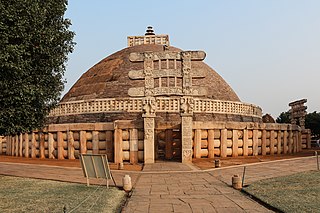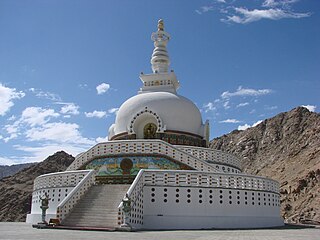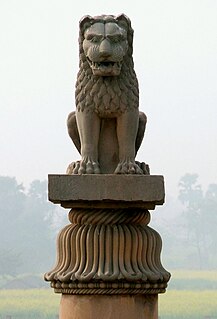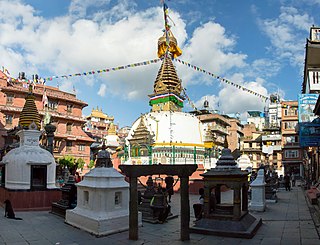Shanti Stupa may refer to:
| This disambiguation page lists articles associated with the title Shanti Stupa. If an internal link led you here, you may wish to change the link to point directly to the intended article. |
Shanti Stupa may refer to:
| This disambiguation page lists articles associated with the title Shanti Stupa. If an internal link led you here, you may wish to change the link to point directly to the intended article. |

A stūpa is a mound-like or hemispherical structure containing relics that is used as a place of meditation. A related architectural term is a chaitya, which is a prayer hall or temple containing a stupa.

Leh is the joint capital and largest town of the union territory of Ladakh in India. Leh, located in the Leh district, was also the historical capital of the Himalayan Kingdom of Ladakh, the seat of which was in the Leh Palace, the former residence of the royal family of Ladakh, built in the same style and about the same time as the Potala Palace in Tibet. Leh is at an altitude of 3,524 metres (11,562 ft), and is connected via National Highway 1 to Srinagar in the southwest and to Manali in the south via the Leh-Manali Highway.

Rajgir is an ancient city and a notified area in Nalanda district in the Indian state of Bihar. The city of Rajgir was the first capital of the kingdom of Magadha, a state that would eventually evolve into the Mauryan Empire. The city finds mention in India's greatest literary epic, the Mahabharata, through its king Jarasandha. Its date of origin is unknown, although ceramics dating to about 1000 BC have been found in the city. The 2,500-year old Cyclopean Wall is located in the city. This area is also notable in Jainism and Buddhism. It was the birthplace of the 20th Jain Tirthankar Munisuvrata, and is closely associated with the arihant Mahavira and Gautama Buddha. Both Lord Mahavira and Lord Buddha taught their beliefs in Rajgir during the 6th and 5th century BC, and the Buddha was offered a forest monastery here by king Bimbisara. As such, the city of Rajgir became one of the Buddha's most important preaching locations. The ancient Nalanda university was located in the vicinity of Rajgir, and the contemporary Nalanda University named after it was founded in 2010 nearby. It was also through Rajgir that the Mauryan Emperor Ashoka travelled to Bodh Gaya around 250 BC, when placing the diamond throne (Vajrasana) at the great temple where Lord Buddha attained enlightenment.

Wardha

A Peace Pagoda is a Buddhist stupa; a monument to inspire peace, designed to provide a focus for people of all races and creeds, and to help unite them in their search for world peace. Most peace pagodas built since World War II have been built under the guidance of Nichidatsu Fujii (1885–1985), a Buddhist monk from Japan and founder of the Nipponzan-Myōhōji Buddhist Order. Fujii was greatly inspired by his meeting with Mahatma Gandhi in 1931 and decided to devote his life to promoting non-violence. In 1947, he began constructing Peace Pagodas as shrines to world peace. The first was inaugurated at Kumamoto in 1954.
Shanti means peace, rest, calmness, tranquility, or bliss.

The Millennium Indraprastha Park is a park on the Outer Ring Road in the east of Delhi, India. It was constructed in 2004 by the Delhi Development Authority. The park includes a children's park, an amphitheatre and a food court.

Dhauli is located on the banks of the river Daya, 8 km south of Bhubaneswar in Odisha, India.

Vaishali or Vesali was a city in present-day Bihar, India, and is now an archaeological site. It is a part of the Tirhut Division.

Somapura Mahavihara in Paharpur, Badalgachhi Upazila, Naogaon District, Bangladesh is among the best known viharas, centres of learning, in the Indian Subcontinent and is one of the most important archaeological sites in the country. It is also one of the earliest sites of Bengal, where significant amount of Hindu statues were found. It was designated as a UNESCO World Heritage Site in 1985. It dates from a period to the nearby Halud Vihara and to the Sitakot Vihara in Nawabganj Upazila of Dinajpur District.

Sunkhani is a village development committee in Nuwakot District in the Bagmati Zone of central Nepal. At the time of the 1991 Nepal census it had a population of 2340 people living in 437 individual households.

Shanti Stupa is a Buddhist white-domed stupa (chorten) on a hilltop in Chanspa, Leh district, Ladakh, in the north India. It was built in 1991 by Japanese Buddhist Bhikshu, Gyomyo Nakamura and part of the Peace Pagoda mission. The Shanti Stupa holds the relics of the Buddha at its base, enshrined by the 14th Dalai Lama. The stupa has become a tourist attraction not only due to its religious significance but also due to its location which provides panoramic views of the surrounding landscape.

Pokhara Shanti Stupa is a Buddhist pagoda-style monument on Anadu Hill of the former Pumdi Bhumdi Village Development Committee, in the district of Kaski, Nepal.
South Delhi Municipal Corporation (SDMC) is one of the municipal corporations in Delhi, India created after the former Municipal Corporation of Delhi was divided into three. Also, it is one of five local bodies in the National Capital Territory of Delhi, the others being North Delhi Municipal Corporation, East Delhi Municipal Corporation, New Delhi Municipal Council and Delhi Cantonment Board.

Vishwa Shanti Stupa (English: World Peace Stupa; in Wardha district, Maharashtra, near Gitai Mandir, is a large stupa of white color. Statues of the Buddha are mounted on stupa in four directions. It also has a small Japanese Buddhist temple with a large park. There is a temple near the stupa where prayers are done for universal peace. The initial pagoda reached completion in 1969. New initiatives in 1993 resulted in the present form. It is one of around 80 Peace Pagodas which have been built around the world by the neo-Buddhist organisation Nipponzan Myohoji. These were a dream of Fujii Nichidatsu, inspired by Mohandas K. Gandhi, as a reaction to the atomic bombing of Japan, the first, and more well known Vishwa Shanti stupa, being built on Ratnagiri Hill in Rajgir.
Bhikshu Gyomo Nakamura is a Japanese Buddhist monk, author and musician.

World Peace Pagoda, also called Nipponzan Peace Pagoda, is a Buddhist monument in Lumbini, Nepal. It was designed and built by Japanese Buddhists at a cost about a million US dollars. The Pagoda acts as the starting point on the central axis of the Lumbini Master Plan, the other end being the Mayadevi Temple. The distance from the pagoda to the temple is about 3.2 km. The stairs in stupa lead to three different levels. The stupa is whitewashed and the floor is stone-paved. It has four large golden statues of Buddha facing four directions.

Kaathe Swayambhu Shree Gha Chaitya is a miniature replica of Swayambhunath. It was built around 1650AD and is one of the popular Tibetan pilgrimage site in Kathmandu, Nepal. The stupa is also called Shree Gha-Shanti Ghat Bhajradhatu Mahachaitya or Kathesimbhu stupa or Kashi Swayambhu.

Shanti Stupa is a Buddhist monument in Delhi, India, intended as "a symbol of universal brotherhood and peace". It is one of several Peace Pagodas in the world. Started by the Nipponzan-Myōhōji-Daisanga religious order of Buddhism, it was inaugurated by the Dalai Lama on 14 November 2007.

Dharmachakra Pravartana Buddha at Sarnath is the famous Gupta period sculpture of the Buddha Shakyamuni in the Dharmachakra Pravartana mudra discovred during the excavations at Sarnath, near Varanasi in Uttar Pradesh, India. It is regarded to be a masterpiece of Gupta craftsmanship and has been widely reproduced. After the Lion Capital of Ashoka, which now serves as the symbol of the nation of India, this is the best known sculpture at Sarnath. This 5 feet 3 inch sandstone sculpture is now preserved at the Sarnath Museum, catalogue no. [B(b)181]